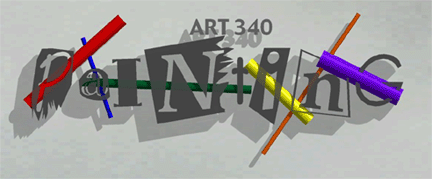FIRST SEMESTER PROJECTS
Assignment 1: Composition and Planes.
This assignment is done in the sketchbook. Students will do a number of drawings of an individual hand-held object. Emphasis is put on the shading and expression of the planes of an object. Value and the rhythms within the work are the primary focus.
Painting 1: High Key Monochrome Painting (Tints).
From Assignment 1, choose a successful composition of the hand-held object. Do a painting on a 9" x 12" canvas board where most of the values are light. All the values will be achieved by adding white to the chosen color. Any color which is derived from adding white is called a tint.
Assignment 2: Hands Sketch.
This assignment is done in the sketchbook. Do three full-page drawings of hands from different points of view. Dramatic lighting is encouraged.
Painting 2: Low Key Monochrome Painting (Shades).
From Assignment 2, choose one of the hands portraits and transfer the drawing to a 9" x 12" canvas panel. Paint the surface with only shades of a color which is the complement of the color used in Painting 1. All the values will be achieved by adding black to the chosen color. Dramatic lighting may be used.
Painting 3: Wrapped Object Imprimatura Painting.
Cover a 9" x 12" canvas panel with a neutral color (burnt umber or raw siena). Choose an engaging object and wrap it in some interesting material be it paper, plastic, cloth, etc... Use string to help articualte the shape of the object within the wrapping. Only 10% of the object can be exposed. Do three thumbnails and choose the most interesting. Then using the wrapped object as subject matter, paint the composition over the prepared canvas, making sure to use some of your medium with the paint. Match color as closely as possible.
Paper 1: Landscape Painting.
Write a two-page paper on a work by an artist who focused on the landscape. The paper should examine the painting's attributes and be accompanied by some images of the artist's work. Note techniques used in the works somewhere in the text.
Painting 4: Landscape with Color Temperature.
Using an 11" x 14" prestretched canvas and several landscape sketches from life, capture the vibrance of the changing seasons. Accentuate the warm and cool colors. Use an underpainting of colors which are not present in the landscape.
Painting 5: Broken Stroke Still Life.
Using Painting 1 as your ground, paint the same object using the broken stroke technique. Apply paint in an impasto fashion. Allow elements of the underpainting to show through. This assignment investigates the concept of painterly space.
Painting 6: Dry Brush Hands Portrait.
Using Painting 2 as your ground, paint your hands portrait using the dry brush technique. Allow elements of the underpainting to show through, but not too much. This assignment also investigates the concept of painterly space.
Assignment 3: Trompe L'oeil Composition.
Using your sketchbook, draw at least three compositions using only geometric shapes. Be aware of rhythms that occur through the repetition of elements, varying sizes of objects, and directional movement. Please no gutters or symmetrical compositions.
Painting 7: Geometric Abstract Trompe L'oeil Painting.
Using an 18" x 24" prestretched canvas, create a collection of geometric forms (sphere, cube, cone, etc.) in a rhythmic composition. The forms must appear to exist in "real" space by using convincing chiaroscuro, and, perhaps, perspective. It will help to look carefully at geometric objects with dramatic lighting. Trompe l'oeil means "fool the eye" in French. You can find information on these concepts at: www2.evansville.edu/studiochalkboard/
Painting 8: Flora Painting.
Create a composition dominated by plants or flowers or both and do a painting (18" x 24" or larger) that balances the brilliance of natural color against neutral tones. This painting may be interpreted from a variety of points of view and may follow the lead set by Master artists of any period from art history.
Painting 9: Mural Project.
The class will be participating in the painting of a large-scale mural. Students will be responsible for a small section. 4 th semester students will act as team coordinators setting working times. This project will introduce students to collaborative projects, public art, and basic organizational skills needed for large-scale works.
Back to top

